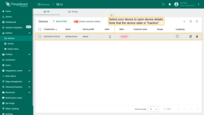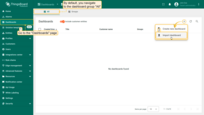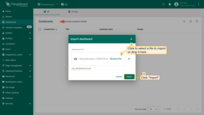- Introduction
- Prerequisites
- Import Rule chain
- Create device profile
- Create device
- Gateway connection
- Check data on ThingsBoard
- Conclusion
Introduction
 The ACE Automation MQTT 4G GPS Gateway is a cutting-edge device that revolutionizes data communication and connectivity
for industrial and IoT applications. Equipped with 4G capabilities, this gateway ensures reliable and high-speed data
transmission over cellular networks, even in remote locations. It integrates GPS technology for real-time location
tracking, ideal for asset and vehicle management. With MQTT as the communication protocol, data exchange becomes
lightweight and efficient, enabling seamless integration into existing IoT ecosystems. Its robust industrial design
guarantees reliable operation in harsh environments, making it a valuable solution for optimizing operations and
harnessing real-time data. Simplify your connectivity and data management with the ACE Automation MQTT 4G GPS Gateway.
The ACE Automation MQTT 4G GPS Gateway is a cutting-edge device that revolutionizes data communication and connectivity
for industrial and IoT applications. Equipped with 4G capabilities, this gateway ensures reliable and high-speed data
transmission over cellular networks, even in remote locations. It integrates GPS technology for real-time location
tracking, ideal for asset and vehicle management. With MQTT as the communication protocol, data exchange becomes
lightweight and efficient, enabling seamless integration into existing IoT ecosystems. Its robust industrial design
guarantees reliable operation in harsh environments, making it a valuable solution for optimizing operations and
harnessing real-time data. Simplify your connectivity and data management with the ACE Automation MQTT 4G GPS Gateway.
Prerequisites
To continue with this guide, we will need the following:
- ACE MQTT 4G GPS Gateway
- Modbus Controller (in our case, Siemens LOGO!)
- ThingsBoard account
Import Rule chain
Download ACE Rule Chain and import.
To import rule chain from а JSON file, you should:
-
Navigate to the “Rule chains” page and click on the “+” button in the upper right corner of the screen and then choose “Import rule chain” option. The toolbar import popup window will appear. Upload a JSON file and click on the “Import” button;
-
The imported rule chain will open. Click on the “Apply changes” button to save the rule chain. Then, go back to the main “Rule chains” page;
-
Rule chain is imported.
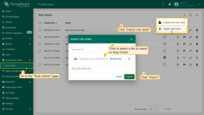
Navigate to the “Rule chains” page and click on the “+” button in the upper right corner of the screen and then choose “Import rule chain” option. The toolbar import popup window will appear. Upload a JSON file and click on the “Import” button;
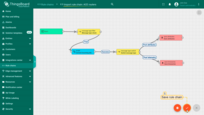
The imported rule chain will open. Click on the “Apply changes” button to save the rule chain. Then, go back to the main “Rule chains” page;
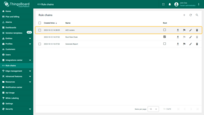
Rule chain is imported.
Create device profile
Now, we are ready to create device profile. For this, follow steps below:
-
Go to Profiles > Device profiles and click on “Add” button > “Create new device profile”;
-
Input Name field with “ACE routers” value, and select “ACE routers” imported rule chain from the step above;
-
Click on “Transport configuration” tab, select MQTT transport type and change Telemetry topic filter value from “v1/devices/me/telemetry” to “siemens/+”, click on “Add” button;
-
Device Profile created.
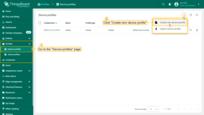
Go to Profiles > Device profiles and click on “Add” button > “Create new device profile”;
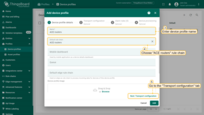
Input Name field with “ACE routers” value, and select “ACE routers” imported rule chain from the step above;
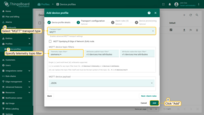
Click on “Transport configuration” tab, select MQTT transport type and change Telemetry topic filter value from “v1/devices/me/telemetry” to “siemens/+”, click on “Add” button;
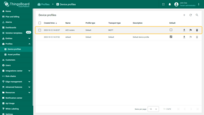
Device Profile created.
Create device
For simplicity, we will provide the device manually using the UI:
-
Open the Devices page. By default, you navigate to the device group “All”. Click on the “+” icon in the top right corner of the table and then select “Add new device”;
-
Input device name. For example, “ACE Gateway”. Select created device profile from the step above, in our case, “ACE routers”;
-
Click on “Credentials” tab. Check “Add credentials” and select “MQTT Basic” credentials type. Click on “Generate” button on each field. Click “Add” button;
-
Device added.
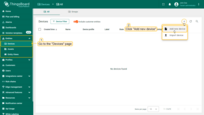
Open the Devices page. By default, you navigate to the device group “All”. Click on the “+” icon in the top right corner of the table and then select “Add new device”;
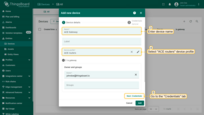
Input device name. For example, “ACE Gateway”. Select created device profile from the step above, in our case, “ACE routers”;
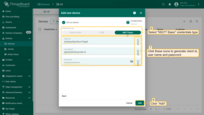
Click on “Credentials” tab. Check “Add credentials” and select “MQTT Basic” credentials type. Click on “Generate” button on each field. Click “Add” button;
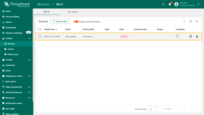
Device added.
Gateway connection
According to the official user manual and this guide, you can connect the gateway to the network and get access to the WebUI in two ways:
|
Your PC must be on the same network as the Gateway: 192.168.8.XXX. If that’s not the case, change the IP address of your PC. For Windows:
For macOS:
For Ubuntu Linux:
|
Now, you can configure the gateway.
Once you are connected to the ACE-GTW-MQTT, you can change its IP address if you wish:
- Network > Interfaces;
- Click on “Edit” the LAN interface;
- Enter a new IP address that is not already being used by another device on your network.
Now we are ready to configure the MQTT connection, topics for data transmission, and establishing the Modbus connection.
Let’s first configure Modbus Connection. As mention above, we use Siemens LOGO! with AM2 RTD module (used for connecting PT100) - which is the perfect choice for the fast, uncomplicated, and space-saving solution of simple control and regulation tasks. LOGO! has long since established itself as an intelligent logic module in small automation projects.
Follow the next steps:
- Go to Gateway > MQTT Configuration > ETHERNET STATIONS LIST (under MQTT Broker section);
- Fill in all required fields with correct information about your device;
- Click on “Save & Apply” button.
In our case, we have the following settings:

For configuring MQTT connection, follow the next steps:
- Go to Gateway > MQTT Configuration > MQTT Broker (tab);
- Fill in all required fields with correct credentials and other information for broker access;
- Click on “Save & Apply” button.

The next thing we have to do is configure MQTT topics for receiving and sending data:
- Go to Gateway > MQTT Configuration > MQTT Broker (tab);
- Scroll down to “MQTT TOPICS LIST : Publishing and Subscribing to MQTT Topics” section;
- Add all topics for publishing data;
- Add all subscription topics for receiving data;
- Click on “Save & Apply” button.
In case Siemens LOGO!, we have the following topics list:

If you are using Siemens LOGO! too, you can use the following configuration:
Check data on ThingsBoard
Once you have successfully done all the steps above and ACE MQTT 4G GPS Gateway sent data, you can see it in the Device Telemetry Tab:
-
Click on the device row in the table to open device details;
-
Navigate to the telemetry tab.
Let’s display ACE MQTT 4G GPS Gateway attributes and telemetry on a dashboard. For this, you can create your own dashboard with your custom widgets or use a ready-made dashboard and simply import it.
Import dashboardYou are able to import a dashboard in JSON format. To import a dashboard, you should go to the Dashboard group and click on the “+” button in the upper right corner of the page and choose “Import dashboard”. The dashboard import window should pop up, and you will be prompted to upload the JSON file and click “Import”. Below, you can find the dashboard JSON file: Check and control device data dashboard After importing, we should choose an entity alias for our device. If you did everything right, you have to see the following dashboard:
|
Conclusion
With the knowledge in this guide, you can easily connect your ACE Automation MQTT 4G GPS Gateway and use the built-in integration to retrieve data from devices connected to ACE Automation MQTT 4G GPS Gateway.
After connecting the devices to the gateway, you will be able to see and process the data coming from the devices on the ThingsBoard.
Explore the platform documentation to learn more about key concepts and features.









